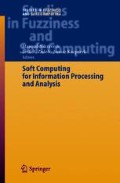Abstract
The goals of this paper are threefold: (1) to introduce SORE to the biocontrol systems research community, describe how it works and explain why it could be an successful basic building block for a biocontrol system, (2) to present the basic characteristics of SORE and Boolean networks (BN) in a modern control language, with emphasis on their mathematical bases, (3) to illustrate, using some simple examples, why SORE’s inherent properties enable it to realize many of the desired basic requirements for a “biologizing” control system. SORE also exhibits self-organizing, reproducing, colonization and grouping actions - essential traits of life. This paper does not report detailed research results; rather, it studies the feasibility of SORE in biocontrol systems based upon computer simulations. Rigorous research results will be presented in the future.
Access this chapter
Tax calculation will be finalised at checkout
Purchases are for personal use only
Preview
Unable to display preview. Download preview PDF.
References
J. L. Casti, “Biologizing” control theory: How to make a control system come alive, Complexity 7(4), 10–12, 2002
Report of the workshop Held at the University of Santa Clara on September 18–19, 1986, Challenges to control: A collective view, IEEE Trans. Automatic Control 32(4), 275–285, 1987
W. B. Cannon, The wisdom of the body, W. W. Norton and Co., New York, 1939
R. Lathrop, Intelligent systems in biology: Why the excitement?, IEEE Intelligent Systems, 8–13, Nov./Dec. 2001
J. Leith et al., Toward more intelligent annotation tools: A Prototype, IEEE Intelligent Systems, 42–51, Nov./Dec. 2001
J. S. Albus, Outline for a theory of intelligence, IEEE Trans. SMC 21(3), 473–509, 1991
J. S. Albus, The engineering of mind, Information Sciences 117, 1–18, 1999
P. P. Wang and H. D. Cheng, “SORE: Self organizable and regulating engine” A research proposal submitted to US NSF, Feb. 20, 2003, File No.: 03248-27, Fastlane
P. P. Wang and J. Robinson, What is SORE, The 7th Proceedings of the Joint Conferences on Information Sciences, Sep. 2003
P. P. Wang et al., A study of the Two-Gene Network-The simplest special case of SORE, The 7th Proceedings of the Joint Conferences on Information Sciences, Sep. 2003
P. P. Wang and H. Tao, A Novel method of error correcting code generation based upon SORE, The 7th Proceedings of the Joint Conferences on Information Sciences, Sep. 2003
P. P. Wang and J. Yu. SORE-A powerful classifier, The 7th Proceedings of the Joint Conferences on Information Sciences, Sep. 2003
T. E. Ideker et al., Discovery of regulatory interactions through perturbation: inference and experiment design, Pacific Symposium on Biocomputing, 5, 302–313, 2000
J. Hammer, On some control problems in molecular biology, Proceedings of 33rd Conference on Decision and Control, 4098–4103, 1994
N. Rashevsky, Mathematical biophysics, The University of Chicago Press, 1948
G. Rozenberg and A. Salomma, L systems, Lecture Notes in Computer Science, 15, Springer Verlag, Berlin, 1975
J. von Neumann, The theory of self-reproducing automata, University of Illinois Press, Urbana, 1966
A. Lyndenmayer, Mathematical models for cellular interactions in development, Parts 1 and 2, J. of Theoretical Biology, 18, 280–315, 1968
S. A. Kauffman, Metabolic stability and epigenesis in randomly constructed genetic nets, J. of Theoretical Biology, 22, 437–467, 1969
IEEE Computer Systems Society, Proceedings of the 1974 Conference on Biologically Motivated Automata Theory, McLean VA, 1974
K. H. Choi and M. Sasaki, Brain-wave bio potentials based mobile robot control: Wavelet-neural network pattern recognition approach, IEEE Int. Conference on SMC, 1, 322–328, 2001
E. Mjolsness and A. Tavormina, The synergy of biology, intelligent systems, and space exploration, IEEE Intelligent Systems, 20–25, Mar./Apr. 2000
R. B. Altman, Challenges for intelligent systems in biology, IEEE Intelligent Systems, 14–18, Nov./Dec. 2001
J. M. Evans et al., Knowledge engineering for real time intelligent control, Proceedings of the 2002 IEEE Int. Symposium on Intelligent Control, Oct. 2002
H. Bolouri, Mechanisms underlying the evolution of robust nonlinear control in biology, Proceedings of the 1999 IEEE Int. Symposium on Intelligent Control/Intelligent Systems and Semiotics, Sep. 1999
P. J. Fleming and R. C. Purshouse, Evolutionary algorithms in control systems engineering: A survey, Control Engineering Practice, 10, 1223–1241, 2002
J. Lancharles et al., Boolean networks decomposition using genetic algorithms, Microelectronics Journal, 28, 551–560, 1997
L. Raeymaekers, Dynamics of Boolean networks controlled by biologically meaningful functions, J. of Theoretical Biology, 218, 331–341, 2002
F. Forgelman-Soulie, Parallel and sequential computation on Boolean networks, Theoretical Computer Science, 40, 275–300, 1985
S. Bilke and F. Sjunnesson, Stability of the Kauffman model, Physical Review E, 65, 016129, 2001
J. A. B. Tome and J. P. Carvalho, Rule capacity in fuzzy Boolean networks, Proceedings of NAFIPS 2002, 27–29, 2002
J. E. Lynch, Critical points for random Boolean networks, Physica D, 172, 49–64, 2002
E. R. Dougherty and I. Shmulevich, Mappings between probabilistic Boolean networks, Signal Processing, 83, 779–809, 2003
C. Gotsman et al., Asynchronous dynamics of random Boolean networks, IEEE International Conference on Neural Networks, 1, 1–7, 1988
M. Dorigo, Learning by probabilistic Boolean networks, IEEE International Conference on Neural Networks, 2, 887–891, 1994
T. Akutsu et al., Identification of genetic networks by strategic gene disruptions and gene overexpressions under a Boolean model, Theoretical Computer Science, 298, 235–251, 2003
M. Sugita, Functional analysis of chemical systems in vivo using a logical circuit equivalent. II. The idea of a molecular automaton, J. of Theoretical Biology, 4, 179–189, 1963
Author information
Authors and Affiliations
Editor information
Editors and Affiliations
Rights and permissions
Copyright information
© 2005 Springer-Verlag Berlin Heidelberg
About this chapter
Cite this chapter
Wang, P.P., Robinson, J., Choi, BJ. (2005). SORE (Self Organizable Regulating Engine) - An Example of a Possible Building Block for a “Biologizing” Control System. In: Nikravesh, M., Zadeh, L.A., Kacprzyk, J. (eds) Soft Computing for Information Processing and Analysis. Studies in Fuzziness and Soft Computing, vol 164. Springer, Berlin, Heidelberg. https://doi.org/10.1007/3-540-32365-1_11
Download citation
DOI: https://doi.org/10.1007/3-540-32365-1_11
Publisher Name: Springer, Berlin, Heidelberg
Print ISBN: 978-3-540-22930-8
Online ISBN: 978-3-540-32365-5
eBook Packages: EngineeringEngineering (R0)

